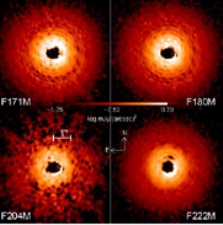Jun 15 2013
A team of researchers has discovered evidence that an extrasolar planet may be forming quite far from its star—about twice the distance Pluto is from our Sun. The planet lies inside a dusty, gaseous disk around a small red dwarf TW Hydrae, which is only about 55% of the mass of the Sun. The discovery adds to the ever-increasing variety of planetary systems in the Milky Way. The research is published in the Astrophysical Journal.*

This dusty protoplanetary disk is the closest one to us, some 176 light-years away in the constellation Hydra. The astronomers made Hubble Space Telescope observations over a wide range of wavelengths from visible to near infrared and modeled the color and structure of the disk in a way that has not been done before. They found a deficit of disk material, or partial gap, at about 80 astronomical units (AU) (1 AU is the Earth/Sun distance). Their models indicate that the depression is about 20 AUs wide, just slightly wider than necessary for a planet-opening gap and consistent with a planet of between 6 and 28 Earth masses. The feature is seen at all wavelengths indicating it is structural and not a local compositional difference. The team believes the evidence is strong for planet formation causing the gap.
“TW Hydrae is between 5 and 10 million years old, and should be in the final throes of planet formation before its disk dissipates,” remarked coauthor Alycia Weinberger of the Carnegie Institution and principal investigator of the observations. “It is surprising to find a planet only 5 to 10% of Jupiter’s mass forming so far out since planets should form faster closer in. In all planet formation scenarios, it’s difficult to make a low-mass planet far away from a low mass star.”
The goal of these observations was to understand not only whether planets have formed, but also what conditions can result in planet formation and what chemical constituents are available for new planets. Models by coauthor Hannah Jang-Condell, a former Carnegie postdoctoral researcher, showed that the disk was brighter than expected, which indicates that very small dust grains are being lifted high above the midplane. This is surprising because observations with radio telescopes have previously shown that the disk contains dust that has conglomerated into pebbles.
Weinberger designed the observations to be able to detect large water ice grains in the surface layer of the disk. These grains weren’t seen, which probably means that they have grown and sunk to the midplane of the disk where they can aggregate into water-rich planets.
Planet formation far away from a small parent star is at odds with the conventional planet-making dogma. Under the most accepted scenario, planets form over tens of millions of years from the slow accretion of dust, rocks, and gas. That happens most easily close to the central star, where orbital timescales are short. Even under a disk instability scenario, in which planets can collapse quickly from the disk, it’s not clear such a low mass planet could form.
Carnegie astrophysicist Alan Boss, who works on disk instability models, said “If the mass of this suspected planet is as low as it seems to be, this presents a real puzzle. Theory would say that it cannot exist!”
Lead author of the study, John Debes of the Space Science Telescope Institute and also a former Carnegie postdoctoral researcher remarked, “Typically, you need pebbles before you can form a planet. So, if there is a planet in the gap and there is no dust larger than a grain of sand farther out, we have provided a challenge for traditional planet formation models.”
*Authors on the study are John Debes, Hannah Jang-Condell, Alycia Weinberger, Aki Roberge, and Glenn Schneider. Support for this work was provided by NASA through the Space Telescope Science Institute, operated by the Association of Universities for Research in Astronomy, Inc., under contract NAS 5-26555. Debes, Jang-Condell and Roberge are all former Carnegie postdoctoral Fellows.